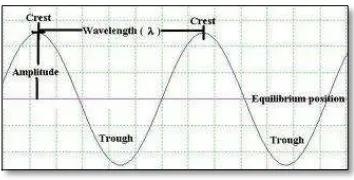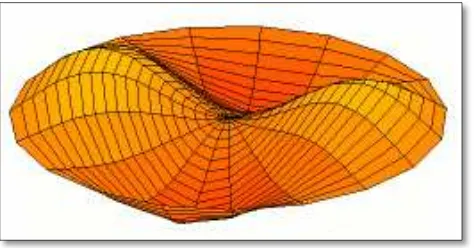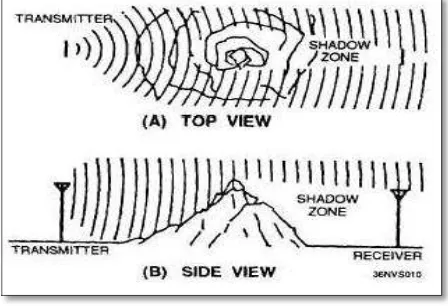NUMERICAL MODELLING OF 1-DIMENSIONAL WAVE EQUATION USING FINITE DIFFERENCE SCHEME
NOR SYAZWANI BINTI MOHD RIDZUN
SUPERVISOR DECLARATION
“I hereby declare that I have read this thesis and in my opinion this report is sufficient in terms of scope and quality for the award of degree of Bachelor of
Mechanical Engineering (Structure and Material).”
NUMERICAL MODELLING OF 1-DIMENSIONAL WAVE EQUATION USING FINITE DIFFERENCE SCHEME
NOR SYAZWANI BINTI MOHD RIDZUN
This report is representing as a partial fulfilment of the requirement for the award of the degree of Bachelor of Mechanical Engineering (Structure and
Material)
Fakulti Kejuruteraan Mekanikal Universiti Teknikal Malaysia Melaka
DECLARATION
“I hereby declare that the work in this report is my own except for summaries and quotations which have been duly acknowledged.”
ACKNOWLEGDEMENT
The author would like to express lots of thanks to all those who helped in completing this project. Lots of thanks to the supervisor, Dr. Md. Fahmi bin Abd Samad @ Madmood for his guidance and motivation on conducting this Final Year Project. Deeply indebted to him for giving time and effort in writing this project.
Besides that, thanks a lot to all management staffs, especially to the lecturers who are in charge in this Final Year Project in Faculty Mechanical Engineering.
ABSTRACT
ABSTRAK
CONTENTS
CHAPTERS TITLE PAGES
ACKNOWLEDGEMENT ii
ABSTRACT iii
ABSTRAK iv
CONTENTS v
LIST OF TABLES viii
LIST OF FIGURES ix
LIST OF SYMBOLS xi
CHAPTER I INTRODUCTION 1
1.1 Background 1
1.2 Problem Statement 2
1.3 Objectives 2
1.4 Scope of Project 2
1.5 Summary 3
CHAPTER II LITERATURE REVIEW 4
2.1 Introduction 4
2.2 Waves 5
2.2.1 Definition of Wave 5
2.2.2 Properties of Wave 6
2.2.4 Types of Mechanical Waves 10
2.3 Wave Equation 14
2.3.1 1-Dimensional Wave Equation 14 2.3.2 2-Dimensional Wave Equation 16 2.3.3 3-Dimensional Wave Equation 16
2.4 Finite Difference Scheme 17
2.4.1 Forward Finite Difference Scheme 19 2.4.2 Backward Finite Difference Scheme 21 2.4.3 Center Finite Difference Scheme 22 2.5 Finite Difference Scheme for 1D Wave
Equation
23
CHAPTER III
METHODOLOGY 25
3.1 Construction of Program in MATLAB 25
3.2 Function Declaration 26
3.3 Identification of Global Parameters 26
3.3.1 Sample Rates (SR) 27
3.3.2 Fundamental Frequency (f0) 28 3.3.3 Duration of Simulation (TS) 28 3.3.4 Center Location (ctr) and Width of
Excitation (wid)
29
3.3.5 Maximum Initial Displacement (u0) and Velocity (v0)
29
3.3.6 Position Readout (rp) 29
3.3.7 Courant Number (lambda) 29
3.3.8 Global Parameters 30
3.4 Derived Parameters 30
3.4.1 Wave Equation Free Parameter 30
3.4.2 Time Step 31
3.4.3 Duration of simulation 31
3.5 Stability Condition 32
3.6.1 Integer Interpolation 33
3.7 Raised Cosine Creation 33
3.8 Grid Functions and Output Initialization 35 3.9 Start of the Main Loop of Finite Difference
Scheme
36
3.10 Output Waveform Plot 36
3.11 Variable Selection and Limitation 37 3.11.1 Position Readout (rp) Variable 37
3.11.2 Lambda Variable 37
3.11.3 Center Location (ctr) Variable 38
CHAPTER IV
RESULT 39
4.1 Program Completion 39
CHAPTER V
DISCUSSION 44
5.1 Variation of Variable Values 44
5.1.1 Position Readout (rp) 45
5.1.2 Lambda 47
5.1.3 Center Location (ctr) 49
5.2 Discussion 52
CHAPTER VI
CONCLUSION 55
REFERENCES 57
LIST OF TABLES
TABLE TITLE PAGES
3.1 The Scheme Grid 33
LIST OF FIGURES
FIGURE TITLE PAGES
2.1 An example of Wave 7
2.2 Transverse Wave 8
2.3 Longitudinal Wave 8
2.4 Ripple Tank of Water Wave 9
2.5 Standing Wave on A Disk (overtone) 9
2.6 (a) Top view and (b) Side view of Ground Wave (radio transmitter propagation)
10
2.7 (a) Spell and (b) Capillary types of Water wave (due to wind)
11
2.8 (a) The Body and (b) Surface wave of Seismis Wave 11
2.9 An example of Shock Wave 12
2.10 A summary of Types of Mechanical Waves 13
2.11 A Part of Vibration String (sub-part) 15
2.12 Example of Spherical Wave Equation 17
2.13 Simple Continuous Function 18
2.14 Simple Continuous Function (for Forward Finite Difference Scheme)
20
2.15 Simple Continuous Function (for Backward Finite Difference Scheme)
21
Difference Scheme)
3.1 An Example of Designed Function Declaration 26
3.2 1D Wave Equation 27
3.3 Samples (the dots) 28
3.4 An Example of Designed Global Parameters 30
3.5 Sampling Frequency (Source: Bruno, 2000) 31
3.6 Raised Cosine 35
4.1 The figure(1) 42
4.2 The figure(2) 43
4.3 The figure(3) 43
5.1 The 1D Wave Equation 44
5.2 Waveform of rp=0.00 45
5.3 Waveform of rp=0.25 45
5.4 Waveform of rp=0.50 46
5.5 Waveform of rp=0.75 46
5.6 Lambda=1.00 47
5.7 Lambda=0.75 48
5.8 Lambda=0.50 48
5.9 Lambda=0.25 49
5.10 Ctr=0.00 50
5.11 Ctr=1.00 50
5.12 Raised Cosine for ctr=0.00 and ctr=1.00 50
5.13 Ctr=0.25 51
5.14 Raised Cosine for ctr=0.25 51
5.15 Ctr=0.50 51
5.16 Raised Cosine for ctr=0.50 52
5.17 Ctr=0.75 52
LIST OF SYMBOLS
f0 = Fundamental frequency, Hz fs = Sampling frequency, Hz f(x) = Function of x
h,Δx = Step size of displacement, x k,Δt = Step size of time, s
N = Sample rate, sample/s
T = Period, s
T = Tension, N
t = Time, s
u,x = Displacement, m
v = Velocity, m/s
x,y = Unknown
CHAPTER I
INTRODUCTION
1.1 BACKGROUND
This research is to study about the wave and the wave equation to make prediction and assumption of physical phenomenon such as in vibrating string. The definition of wave is forward or backward propagating directions that transfer of energy in a system. In the mathematical sense, a wave is any function that moves.
The linear wave equation is widely used model in mathematical physics. However, explicit solutions for this equation when the wave speed varies spatially can only be obtained in certain special cases. These solutions are nevertheless useful to describe wave propagation and to test numerical algorithms. Based on the scope of this thesis; the focused is on 1-dimensional wave equation.
and just exist in plane wave. Means that, the derivation of 1-dimensional equation is from second partial derivatives and can be derived by using Maxwell and Newton’s 2nd Law equation. The finite difference scheme was used to derive the second partial derivatives and be model in type of numerical modelling in MATLAB.
1.2 PROBLEM STATEMENT
This research to perform numerical modeling of behavior of 1D wave equation by using finite difference scheme and to investigate the behavior of 1D wave through the variation of the system’s parameters. The numerical modeling is designed to calculate the 1-dimensional wave equation by using finite difference schemes method. The finite difference approximation is a numerical technique based on the finite difference concept from Taylor series that is employed to solve Maxwell’s equation and well suited to analyze problems with complex geometrical features like 1-dimensional wave equation.
1.3 OBJECTIVES
The main objective of this research is to perform numerical modeling of the behavior of 1D wave equation by using finite difference scheme. Other objective is to investigate the behavior of 1D wave through the variation of the system’s parameters.
1.4 SCOPE OF PROJECT
The scope of this project is all the simulations, manipulations and implementations must be done by using MATLAB.
geometrical features that include parameters such as frequency, velocity and time.
The centered approximation of finite difference scheme is used in this study because it is widely used. Besides that, the 1-dimensional wave equation can be solve by using centered approximation of finite difference scheme by introducing the initial velocity condition according to Pierce (2012).
1.5 SUMMARY
CHAPTER II
LITERATURE REVIEW
2.1 INTRODUCTION
The purpose of this project is to do a numerical modelling of 1-dimensional wave equation by using finite difference scheme.
At present, many commercial software have been developed and used widely, these software contain numerical methods with some specific procedures to provide approximate solutions. Thus, it is very important for users to understand the computational procedures that are built inside the software prior to using them. In this project, all the computational procedure will be done by using MATLAB.
According to Goering (2004), the MATLAB (matrix laboratory) is a numerical computing environment and fourth-generation programming language. This programming was developed by MathWorks that allows matrix manipulations, plotting of functions and data, implementations of algorithms and creation of user interfaces.
The most important aspect for a student who needs to learn numerical modelling by using computer language is that the methods and their computational procedures must be understood clearly prior to developing any computer program.
2.2 WAVES
2.2.1 Definition of Wave
A wave has the same sense as a particle. Wave is a disturbance or oscillation that travels through space-time and also transferring energy. Wave is a disturbance that moves through a medium. A medium here is a substance or material that carries the disturbance from one point or place to another.
A wave is a transfer of energy from one point to another. There are two basic types of wave; a wave can be transverse or longitudinal depending on the direction of its oscillation.
The transverse wave is the wave that causes the medium to vibrate at a right angle to the direction of the wave. The transverse wave has crest (highest point) and trough (lowest point) of the wave. An example of transverse wave is light wave (electromagnetic wave).
The longitudinal wave (also known as l-wave) is the wave has the same direction of vibration as their direction of travel. According to Richard, (2005), the characteristic of longitudinal wave is same with compression and extension wave in spring.
But, any kinds of waves have same properties either its longitudinal or transverse wave such as amplitude, wavelength, period, frequency and speed.
2.2.2 Properties of Wave
The main properties of a wave are defined below and as illustrated in the Figure 2.1.
i. Amplitude: the height of the wave from equilibrium position line to crest, measured in meters.
ii. Wavelength: the distance between a crest to another crest, measured in meters.
iv. Frequency: the number of crest that pass a point in one second, measured in inverse seconds or Hertz (Hz).
v. Speed: the horizontal speed of a point on a wave as it propagates or the number of crest passages per unit time, measured in meters / second.
Figure 2.1: An example of Wave (Adapted from butane.chem.uiuc.edu)
2.2.3 Dimensions of Waves
There are three types of wave that known as 1-dimension, 2-dimension and 3-dimension of waves. All the waves are differentiating by it point of source and path of the wave propagate.
i. 1-Dimensional Wave:
Examples of wave in one dimension are a wave that travels along string or sound waves going down a narrow tube. The energy of the wave motion of a 1-dimensional wave has only one dimension in which to travel. The waves that have only one dimension to travel are transverse and longitudinal wave.
Figure 2.2: Transverse Wave (Adapted from physics.tutorvista.com)
Then, the longitudinal wave is the motion of the points of the medium (forming the wave) is in the same direction as the direction of propagation of the wave pattern as shown in Figure 2.3. The examples of longitudinal waves are the spring coil, sound waves, ultrasonic waves, shock waves (sonic booms), light waves and so on. The longitudinal wave in slinky spring are contains in compression and extension of the spring as mentioned by Richard et. al. (2005) and as shown in Figure 2.3.
Figure 2.3: Longitudinal Wave
(Adapted from www.mundos-fantasticos.com)
ii. 2-Dimensional Wave
By referring to Kneubühl (2010) stated that the energy of the wave motion of a 2-dimensional wave has the ability to travel around corners. The wave has a point of source and a path of the wave. An example is a ripple tank that contains water waves as illustrated in Figure 2.4.
Figure 2.4: Ripple Tank of Water Wave (Adapted from Drum_vibration_mode01.gif)
iii. 3-Dimensional Wave
The 3-dimensional wave is a wave that shows point sources, line sources and plane of wave such as the wave moving into different medium also called, interference between sources is the definition gave by Kneubühl (2010). For an example, a standing wave on a disk (as shown in Figure 2.5) with two nodal lines crossing at the centre (overtone)
2.2.4 Types of Mechanical Wave
The wave equation is a part of mechanical wave that can be derived in vibrating string. A mechanical wave is a wave that needs a medium to travel and cause a local oscillation of material. The mechanical wave is also known as material wave. The mechanical wave can be divided into four types.
The first type of mechanical wave is surface wave or also known as ground wave. The surface wave is a mechanical wave that propagates along the interface between differing media or two fluids that have different densities or refractive index gradient. The suitable example of surface wave is radio propagation that travels as ground wave as shown in Figure 2.6. When the wave travels in low frequency, the wavelength of the wave is high due to the diffracted around obstacles.
Figure 2.6: (a) Top view and (b) Side view of Ground Wave (radio transmitter propagation)
(Adapted from www.edinformatics.com)



